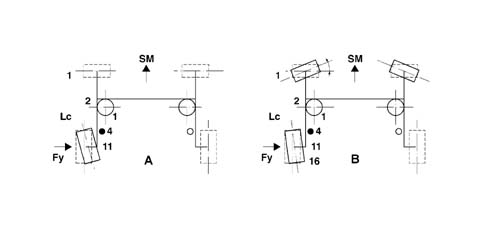3363711 - Introduction - SUSPENSION AND WHEELS
SUSPENSION
SPECIFICATIONS
The suspension allows a car to tackle any type of route without transmitting wheel bumpiness inside the car and reducing lateral and longitudinal body oscillations (roll and pitch respectively). The suspension also damps vertical movements and keeps the wheels firmly on the ground.The suspension should therefore ensure passenger comfort, driveability and road holding.In order to produce maximum performance the chassis has been redesigned, altering the rear and centre platforms and the struts.This has led to a different track (60 mm longer) compared with the Bravo/a.Front suspension
The front suspension is the Mc Pherson type where the shock absorbers and springs act as both damping and flexible elements as well as having a structural and kinematic function.In particular, the main components are:
- differently designed coil springs with an improved capacity for absorbing road bumpiness.
- track control arms with rubber/metal front bushes and new rubber/metal rear bushes with a vertical - axle* for improved driving comformt and ensuring better road holding.
- a crossmember for the new suspension arms.
- double-acting, telescopic, hydraulic shock absorbers with hydraulic end of travel to ensure damping of vertical oscillations without transmitting and generating noise and vibrations.
- split upper suspension mountings at the bodyshell. This system is designed to guarantee the discharge of the spring force and filter vibrations coming from the shock absorbers.
Rear suspension
The rear suspension on the Stilo is a classic design with (semi-independent) wheels connected by means of a torsion axle.Hydraulic bushes have been adopted to guarantee maximum noise filtration giving improved driving comfort (reduced noise/vibrations).The shock absorber attachment has been altered from inclined under the floor to vertical with the mounting in the wheel arch.The upper damper attachment is fitted with bushes with reduced dynamic rigidity developed specially for this model. These absorb vertical forces by filtering out even high frequency vibrations induced by road surface roughness.This solution features a torsion beam produced through a pressing process which ensures the ideal suspension torsional rigidity and, therefore, an excellent balance between the front and rear of the car.A more stable drive has been achieved by attaching the beam to the body using hydraulic bushes. These have also been specially developed for this model and are able to create a toe-in effect on corners to ensure excellent driving stability even under extreme conditions.